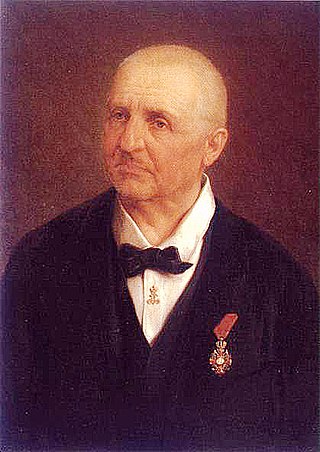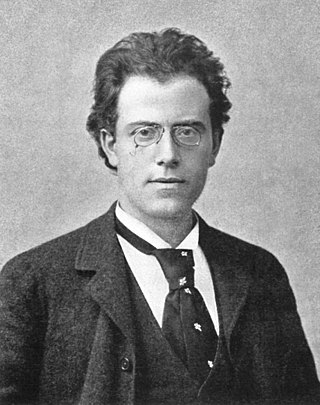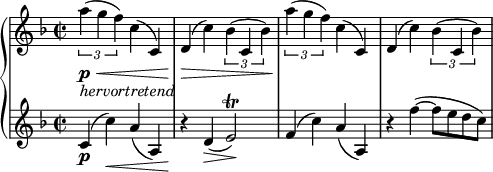
Joseph Anton Bruckner was an Austrian composer and organist best known for his symphonies and sacred music, which includes Masses, Te Deum and motets. The symphonies are considered emblematic of the final stage of Austro-German Romanticism because of their rich harmonic language, strongly polyphonic character, and considerable length. Bruckner's compositions helped to define contemporary musical radicalism, owing to their dissonances, unprepared modulations, and roving harmonies.

The Symphony No. 1 in D major by Gustav Mahler was mainly composed between late 1887 and March 1888, though it incorporates music Mahler had composed for previous works. It was composed while Mahler was second conductor at the Leipzig Opera in Germany. Although in his letters Mahler almost always referred to the work as a symphony, the first two performances described it as a symphonic poem and as a tone poem in symphonic form, respectively. The work was premièred at the Vigadó Concert Hall in Budapest, Hungary, in 1889, but was not well-received. Mahler made some major revisions for the second performance, given at Hamburg, Germany, in October 1893; further alterations were made in the years prior to the first publication, in late 1898. Some modern performances and recordings give the work the title Titan, despite the fact that Mahler only used this label for the second and third performances, and never after the work had reached its definitive four-movement form in 1896.

The Symphony No. 4 in G major by Gustav Mahler was composed from 1899 to 1900, though it incorporates a song originally written in 1892. That song, "Das himmlische Leben", presents a child's vision of heaven and is sung by a soprano in the symphony's Finale. Both smaller in orchestration and shorter in length than Mahler's earlier symphonies, the Fourth Symphony was initially planned to be in six movements, alternating between three instrumental and three vocal movements. The symphony's final form—begun in July 1899 at Bad Aussee and completed in August 1900 at Maiernigg—retains only one vocal movement and is in four movements: Bedächtig, nicht eilen ; In gemächlicher Bewegung, ohne Hast ; Ruhevoll,poco adagio ; and Sehr behaglich.

Anton Bruckner's Symphony No. 5 in B-flat major WAB 105, was written in 1875–1876, with minor changes over the next two years. It came at a time of trouble and disillusion for the composer: a lawsuit, from which he was exonerated, and a reduction in salary. Dedicated to Karl von Stremayr, education minister in the Austro-Hungarian Empire, the symphony has at times been nicknamed the "Tragic", the "Church of Faith" or the "Pizzicato"; Bruckner himself referred to it as the "Fantastic" without applying this or any other name formally.

The Symphony No. 6 in A major, WAB 106, by Austrian composer Anton Bruckner (1824–1896) is a work in four movements composed between 24 September 1879, and 3 September 1881 and dedicated to his landlord, Anton van Ölzelt-Newin. Only two movements from it were performed in public in the composer's lifetime. Though it possesses many characteristic features of a Bruckner symphony, it differs the most from the rest of his symphonic repertory. Redlich went so far as to cite the lack of hallmarks of Bruckner's symphonic compositional style in the Sixth Symphony for the somewhat bewildered reaction of supporters and critics alike.

Anton Bruckner's Symphony No. 7 in E major, WAB 107, is one of the composer's best-known symphonies. It was written between 1881 and 1883 and was revised in 1885. It is dedicated to Ludwig II of Bavaria. The premiere, given under Arthur Nikisch and the Gewandhaus Orchestra in the opera house at Leipzig on 30 December 1884, brought Bruckner the greatest success he had known in his life. The symphony is sometimes referred to as the "Lyric", though the appellation is not the composer's own, and is seldom used.

Anton Bruckner's Symphony No. 8 in C minor, WAB 108, is the last symphony the composer completed. It exists in two major versions of 1887 and 1890. It was premiered under conductor Hans Richter in 1892 at the Musikverein, Vienna. It is dedicated to the Emperor Franz Joseph I of Austria.

The Symphony No. 9 in D minor, WAB 109, is the last symphony on which Anton Bruckner worked, leaving the last movement incomplete at the time of his death in 1896; Bruckner dedicated it "to the beloved God". The symphony was premiered under Ferdinand Löwe in Vienna in 1903.

Anton Bruckner's Symphony No. 1 in C minor, WAB 101, was the first symphony the composer thought worthy of performing and bequeathing to the Austrian National Library. Chronologically it comes after the Study Symphony in F minor and before the "nullified" Symphony in D minor. The composer gave it the nickname Das kecke Beserl, and conducted its 1868 premiere. Much later, after Bruckner was granted an honorary University of Vienna doctorate in 1891, he dedicated the 1890–1891 version of the work to that institution.

Anton Bruckner's Symphony No. 2 in C minor, sometimes known as the "Symphony of Pauses", was completed in 1872. It was actually the fourth symphony composed by Bruckner, after the Symphony in F minor (1863), the Symphony No. 1 in C minor (1866), and the Symphony in D minor (1869).

Anton Bruckner's Symphony No. 4 in E-flat major, WAB 104, is one of the composer's most popular works. It was written in 1874 and revised several times through 1888. It was dedicated to Prince Konstantin of Hohenlohe-Schillingsfürst. It was premiered in 1881 by Hans Richter in Vienna to great acclaim.

At the end of his study period in form and orchestration by Otto Kitzler, Anton Bruckner made on 7 January 1863 sketches for a Symphony in D minor, WAB add 244.
Bruckner did not go on with this project, but composed later in the same year the Symphony in F minor, WAB 99.

The Te Deum in C major, WAB 45, is a setting of the Te Deum hymn, composed by Anton Bruckner for SATB choir and soloists, orchestra, and organ ad libitum.

Anton Bruckner's String Quintet in F major, WAB 112 was composed in 1878/79 in Vienna.

The Symphony in D minor, WAB 100, was composed by Anton Bruckner in 1869 between Symphony No. 1 (1866) and Symphony No. 2 (1872). In 1895 Bruckner declared that this symphony "gilt nicht" and he did not assign a number to it. The work was published and premiered in 1924.
There have been many different versions and editions of the symphonies of Anton Bruckner.

The Bruckner Gesamtausgabe is a critical edition of the works of Anton Bruckner. Published by Musikwissenschaftlicher Verlag Wien in Vienna, it comprises three successive editions.

The Symphonisches Präludium in C minor, WAB add 332, is an orchestral composition by Anton Bruckner or his entourage, composed in 1876. The work was discovered shortly after World War II. Heinrich Tschuppik, who found the orchestral score of the work in the estate of Bruckner's pupil Rudolf Krzyzanowski, attributed the authorship to Bruckner. Thirty years later, Mahler scholar Paul Banks, who knew only a four-stave reduction of the work, proposed that the work might be attributed to Mahler. While the exact circumstances of the composition of this Prelude have not been determined, it is certain to have been composed within the circle of Bruckner and his students at the Vienna Conservatory of Music. Based on the original orchestral score, it seems likely that the work was at least sketched by Bruckner, possibly as an exercise in orchestration for Krzyzanowski.
The Austrian composer Anton Bruckner composed eleven symphonies, the first, the Symphony in F minor in 1863, the last, the unfinished Ninth symphony from 1893 to 1896.

Gerd Schaller is a German conductor, best known for his performing and recording rare works, including the first full recordings of Bruckner's output.






















